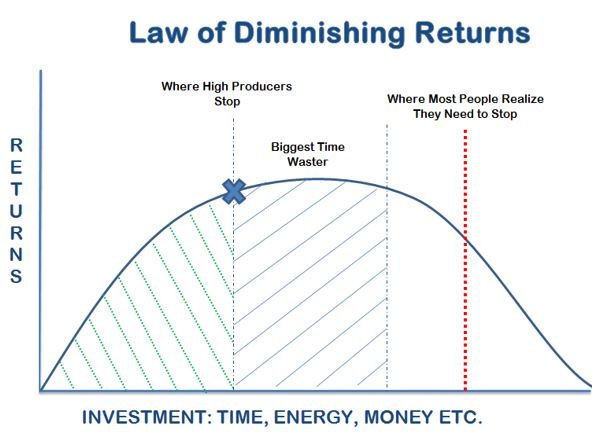The Law of Diminishing Returns
The Law of Diminishing Returns
The most important rule of time management, (and of economics) goes under two different names.
- 80 - 20 rule.
- The law of diminishing returns.
The two rules (or laws), mean the same thing: namely, that "more is not necessarily better".
More is not necessarily better.
As children we soon recognise that some things are good.
- Chocolate tastes good.
- Coca cola is good.
- Playing around with friends is good.
Later, as teenagers we might discover that lying in bed until midday is good. Alcohol is good.
Then we make a terrible mistake - we figure that if something is good, then more must be better.
It seems self-evident truth that if something is good, more would be better; and even more would be even better.
- So, if some chocolate is good, more chocolate is better.
- If some Coca cola is good, more is better.
- If one Big Mac is good, two is better.
- If one bottle of wine is good, two is better.
- If lying around doing nothing feels good, more lying around doing nothing is better.
This conclusion; that more is better, is a disaster.
More is not necessarily better.
There comes a point of diminishing returns.
Diminishing Returns
The point of Diminishing Returns is, where a particular good reaches an optimum level, and any addition beyond that level, is of no added benefit. And if you continue to add more, then the addition of more, becomes worse than useless, it becomes counter-productive.
For example: Having a drink of wine makes you feel good. But there is an optimum level of wine consumption, any more than that will make you feel sick.
Taking aspirin can ease pain. However, there is an optimum "therapeutic dose" of aspirin (which is quite low), any more than that dose will be no-good as pain relief, and if you have too much, you will poison yourself.
80 -20 rule
80-20 rule states the same idea, in different words.
80-20 says that 80% of the value is contained in 20% of the volume. And that any more than that initial 20% may be of minimal value and may even be counterproductive.
For example:
- One cook in the kitchen can do good work.
- Two cooks in the kitchen may do excellent work.
- But seven cooks in the same kitchen will probably be catastrophic.
In many situations it would be useful to figure out the answer to this question. Where is the point of diminishing returns?
In the gym, half an hour of hard training may be very beneficial. One hour of heavy training may be pushing the limits of endurance and safety. Two hours of heavy training may break your back.
In a romantic relationship, an occasional argument may be beneficial to clear the air. More arguments do not add much to the relationship. Even more arguments will break the relationship.
Even with regard to money, two million pounds would probably help you and your family. Four million pounds would not help much more than the two million would do. Ten million pounds may ruin you and your kids. (See Bob Geldof for details.)
Remember, more is not necessarily, better.
There is a point which is optimum. This is the point of diminishing returns, where additional amounts of time, money and effort are ineffective and may even be dangerous.
Your job is to think this over and work up to the optimum point.
- Find the Optimum consumption. Don't consume any more than the optimum amount.
- Find the Optimum level of effort. Don't do any more than the optimum.
- Find the Optimum amount of time invested. Don't waste your time on fruitless additional repetitions.
Apply the law of diminishing returns and see for yourself how powerful this idea is. Examine this graph.

Definition: law of diminishing returns
In business and time management, the law of diminishing returns is a rule that once input moves past its best point, each extra bit of time, money or effort brings a smaller reward than the one before. Beyond that, output stops rising and can even fall, so wise people stop at the peak.
Show CG4D Definition
- Extra gain falls once input passes the best point
- Shows the best point where added input gives no extra reward
- Input beyond that point can cut total output
- Applies to all resources, such as time, money, labour and goods
Article Summary
The law of diminishing returns, also called the 80-20 rule, shows that most value sits in a small share of effort; once you pass the optimum point, extra time, money or force give less and soon harm results, so wise people track the peak, stop at enough and move on.
Frequently Asked Questions
Here are some questions that frequently get asked about this topic during our training sessions.
What is the law of diminishing returns?
How does the 80-20 rule fit with diminishing returns?
Can you show a daily example of diminishing returns?
How do I work out my personal optimum point?
Why might longer gym sessions hurt progress?
Does the law of diminishing returns apply to money?
What if I ignore the law of diminishing returns?
Thought of something that's not been answered?
Did You Know: Key Statistics
A 2021 Stanford University study of 5,000 UK workers found output per hour falls by 25% once weekly hours pass 55, showing longer weeks bring no extra value. The 2024 Global Wellness Institute survey of 12,000 adults showed people who exercise 150–300 minutes a week gain a 30% lift in well-being, but those doing over 600 minutes add only 5% more, a clear sign of diminishing returns.Blogs by Email
Do you want to receive an email whenever we post a new blog? The blogs contain article 5-10 minutes long - ideal for reading during your coffee break!
Further Reading in Decision Making and Problem Solving
-
How Rational Thinking is the Key to Success
Learn how rational thinking and logical reasoning help you align with natural laws, remove contradictions and reach lasting success at work and in life.
Read Article > -
How To Solve Problems
Learn a proven 10-step problem solving method that tames fear, gathers facts, sets clear plans and tracks results. Boost critical thinking at work or home.
Read Article > -
Influencing Decisions When You're Not the Most Senior Person
Learn how to influence decisions and persuade senior leaders with clear thinking, precise language, solid evidence and confident delivery, even without a title.
Read Article > -
Decision Making and Problem Solving Training
Boost results with practical problem solving training and decision making training. Master three methods and four key choices to act faster and smarter.
Read Article > -
When and How to Use the Five Whys Technique
Discover how the improved Five Whys technique examines natural law, material, design and intent, so you reach the root cause and prevent repeat faults.
Read Article >
Looking for Leadership and Management Training?
If you're looking to develop your Decision Making and Problem Solving Skills, you may find this Leadership and Management Training Course beneficial:
Open Training Course Pricing and Availability
Next Open Course Starts in 32 days, Cardiff, places available







